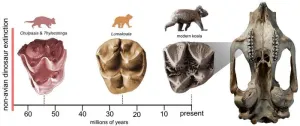(Press-News.org) September 7, 2023—(BRONX, NY)—In findings with potentially important implications for cervical cancer screening, scientists at the National Cancer Institute (NCI)-designated Montefiore Einstein Cancer Center (MECC) have developed a test for detecting a type of cervical cancer that Pap tests often miss. The findings published online today in the Journal of the National Cancer Institute (JNCI).
“Our novel test appears sensitive for detecting cervical adenocarcinoma [ADC]—which now accounts for up to 25% of cervical cancer cases—as well as its precursor lesions, adenocarcinoma in situ [AIS], that often develop into ADCs,” said Howard Strickler, M.D., M.P.H., co-senior and corresponding author of the JNCI paper and a member of MECC.
“Because ADCs are often missed by current screening methods, they have higher mortality rates than the more common cervical squamous cell cancer,” Dr. Strickler added. “Our goal is to catch the disease early, before it develops into cancer.” Dr. Strickler is also professor and head of the division of epidemiology and the Harold and Muriel Block Chair in Epidemiology and Population Health at Albert Einstein College of Medicine.
A Novel Approach to Testing
The widespread use of the Pap test, in which a pathologist examines tissue samples for abnormal cells, has significantly reduced the incidence of cervical squamous cell cancer over the past six decades. However, the incidence of ADC has not decreased, probably because the Pap test is less effective at detecting it.
In recent years, testing for human papillomaviruses (HPVs)—which cause virtually all cases of cervical cancer—joined the Pap test as a standard screening tool for cervical cancer. Although there are more than 100 types of HPV, three types—HPV 16, 18, and 45—account for more than 70% of all cervical cancer cases and more than 90% of ADC cases. The current HPV tests cover all three types and can alert infected women that they face a high risk for developing cervical cancer. While vaccines for preventing cervical cancer—including Gardasil-9, which protects against nine HPV types—are safe and effective, several generations of women are above the age for receiving the vaccine. Therefore, screening and treatment for prevention of cervical cancer will remain critical for decades to come.
The MECC-developed HPV test assessed HPV 16, 18, and 45 in a novel way: by specifically looking at methylation levels. “The advent of next-generation genetic testing has opened up opportunities for us to more accurately detect oncogenic HPV strains and patterns in the genomes that correspond with the development of AIS and ADC,” said Robert D. Burk, M.D., professor of pediatrics, of microbiology & immunology, of epidemiology and population health, and of obstetrics & gynecology and women’s health at Einstein and MECC member, who co-led the study.
Methylation—the addition of methyl (CH3) groups to a region of DNA—is a routine occurrence in DNA, both viral and human, and plays a critical role in altering gene expression. The JNCI study, a collaborative project with the NCI, part of the National Institutes of Health, investigated methylation levels in cervical tissue samples from 1,400 women who had undergone cervical cancer screening at Kaiser Permanente Northern California before 2014 and whose cervical cancer status was known.
In assessing the HPVs in the cytological samples, the researchers tallied up the methylation percentages for each of 35 different viral-genome sites, with each sample receiving a final “methylation score” equal to the average methylation percentage across all 35 sites. Those women with methylation scores in the upper 25% had very high odds for having developed either ADC or AIS.
“Our findings, if confirmed by clinical trials, suggest that women with a high methylation score may benefit from colposcopy and specialized tissue evaluation, beyond just a Pap test, which could lead to early diagnosis and treatment for ADC or the removal of AIS lesions before they develop into ADC,” said Dr. Burk.
Improving Equity in Cervical Cancer Screening
“Given that our test uses equipment that could be simplified, it has the potential to expand testing in lower-resourced countries,” said Dr. Strickler, who has long studied HPV in women living with HIV, who are more likely to acquire an HPV infection.
Cervical cancer remains the fourth most common type of cancer in women, with the burden significantly higher in lower- and middle-income countries, including those in Sub-Saharan Africa, where HIV-HPV coinfections are common. There are also significant disparities within the United States. In New York City, rates of cervical cancer in the Bronx, which is home to the poorest urban congressional district in the country, are 50% higher than in Manhattan. More frequent and effective screening could help address this health disparity.
“Ideally, the new HPV methylation test would only need to be done once every three to five years,” said Dr. Strickler. “We are hopeful that this test will be able to increase cervical cancer screening equity in the U.S. as well.”
The paper is titled “A Novel HPV/Host DNA Methylation-Score and Detection of Cervical Adenocarcinoma.” In addition to Drs. Strickler and Burk, other Einstein authors on the study were Ana Gradissimo, Ph.D., Xiaonan Xue, Ph.D., and Philip E. Castle, Ph.D, M.P.H. (also affiliated with the NCI). Other contributors were Megan A. Clarke, Ph.D., M.H.S., Mark Schiffman, M.D., M.P.H., and Nicolas Wentzensen, M.D., Ph.D., M.PH., all at NCI, and Tina R. Raine-Bennett, M.D., M.P.H. at Kaiser Permanente.
***
About Montefiore Einstein Cancer Center
Montefiore Einstein Cancer Center (MECC) is a national leader in cancer research and care located in the ethnically diverse and economically disadvantaged borough of the Bronx, N.Y. MECC combines the exceptional science of Albert Einstein College of Medicine with the multidisciplinary and team-based approach to cancer care of Montefiore Health System. Founded in 1971 and a National Cancer Institute (NCI)-designated Cancer Center since 1972, MECC is redefining excellence in cancer research, clinical care, education and training, and community outreach and engagement. Its mission is to reduce the burden of cancer for all, especially people from historically marginalized communities.
END
Koalas are endangered in much of Australia now but in in the past there were multiple species living across the continent. The discovery of an ancient relative of the koala helps fill a 30 million year gap in the amazing evolution of Australia’s marsupials, according to a new study by Australian and British scientists published in Scientific Reports.
The study was led by Flinders University PhD student Arthur Crichton, who found fossil teeth of the new species at the Pwerte Marnte Marnte fossil site south of Alice ...
More than 50% of Australians living in residential aged care facilities have a dementia diagnosis, with aged care services around the world preparing for the number of older people aged 65 years and above to double in the next 30 years.
For the first time, experts at the Caring Futures Institute at South Australia’s Flinders University are using innovative eye-tracking technology to ensure that the voices of all older people are heard to drive positive and effective change in keeping with the Royal Commission into Aged Care Quality and Safety’s call to re-assess the quality of aged care in Australia.
The Flinders University ...
In recent years, the escalating impact of global warming has prompted efforts to reverse troubling trends, often by planting trees to capture and remove carbon dioxide from the atmosphere and store it. New research from a team led by Young Zhou, from the Quinney College of Natural Resources and the Ecology Center, shows that, in addition to trees, humble grasses also play an essential role in capturing carbon — more important than previously thought.
A recent initiative set its sights on capturing carbon in tropical savannas, an ecosystem characterized by shared space of trees and grasses. The project initiated ...
Mental health and substance use disorders are prevalent among people experiencing homelessness, yet access to care for these health issues is challenging for people living on the streets. Now, a new survey conducted by a team of researchers from USC Street Medicine found that, in California, street medicine programs are helping to fill this gap, delivering critical, high-level mental health and substance use treatments to the state’s unsheltered population.
The survey, published in Community Mental Health Journal, shows that street medicine has the potential to serve as the basis for a strategy to expand access to behavioral health care for people who ...
A team of scientists from the University of California, Irvine, believe they have discovered a special antibody which may lead to a treatment for Retinitis Pigmentosa, a condition that causes loss of central vision, as well as night and color vision.
The study, Structural basis for the allosteric modulation of rhodopsin by nanobody binding to its extracellular domain, was published in Nature Communications. Authors of the study were Arum Wu, PhD, David Salom, PhD, John D. Hong, Aleksander Tworak, PhD, Philip D. Kiser, PharmD, PhD, and Krzysztof Palczewski, PhD, in the Department ...
Women who use non-steroidal anti-inflammatory painkillers alongside hormonal contraception appear to be at a small increased risk of blood clots known as venous thromboembolism (VTE), finds a large Danish study published by The BMJ today.
The risk was greater in women using combined oral contraceptives containing third or fourth generation progestins, but smaller in women using progestin-only tablets, implants and coils, alongside the non-steroidal anti-inflammatory drugs (NSAIDs) ibuprofen, diclofenac, and naproxen.
The researchers stress ...
High intake of several emulsifiers (part of the ‘E numbers’ group of food additives), widely used in industrially processed foods to improve texture and extend shelf-life, is associated with increased risk of cardiovascular disease (CVD), suggests a study published by The BMJ today.
Given that these food additives are used ubiquitously in thousands of widely consumed ultra-processed food products, these findings have important public health implications, say the researchers.
Emulsifiers are often added to processed and packaged foods such as pastries, cakes, ice cream, ...
Rochester Institute of Technology researchers are improving non-invasive treatment options for degenerative disc disease, an ailment that impacts 3 million adults yearly in the U.S., according to the Mayo Clinic.
Using state-of-the-art gene editing technology in mesenchymal stem cells, the researchers will add to the growing field of regenerative medicine, the process of producing cellular therapies to alleviate pain and lack of mobility.
Karin Wuertz-Kozak and Thomas Gaborski, faculty-researchers in RIT’s Kate Gleason College of Engineering, recently received a National Institutes of Health award for “Extracellular vesicles produced by CRISPR-activated ...
As the second most popular social media platform in the world, YouTube frequently attracts criticism. In particular, critics argue that its algorithmic recommendations facilitates radicalization and extremism by sending users down "rabbit holes" of harmful content.
According to a new study published in Science Advances, however, exposure to alternative and extremist video channels on YouTube is not driven by recommendations. Instead, most consumption of these channels on the platform can be attributed to a small group of users high in gender and racial resentment who ...
WASHINGTON, Sept. 6, 2023 – Though a cornerstone of thermodynamics, entropy remains one of the most vexing concepts to teach budding physicists in the classroom. As a result, many people oversimplify the concept as the amount of disorder in the universe, neglecting its underlying quantitative nature.
In The Physics Teacher, co-published by AIP Publishing and the American Association of Physics Teachers, researcher T. Ryan Rogers designed a hand-held model to demonstrate the concept of entropy for students. Using everyday materials, Rogers’ approach allows students to confront ...





